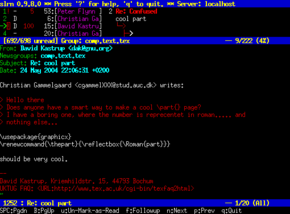Usenet is a pioneering ordinateur[1] network communication system, developed in 1980. It’s built on a framework known as UUCP, which allows mail exchange, file transfers, and public announcements. Usenet hosts vast amounts of data, organized into specific areas of interest called newsgroups, and further into threads created by article responses. Unlike other platforms, Usenet doesn’t require personal registration. It stores no information on a remote server, and its archives are always accessible. Users can connect to Usenet through various Internet[2] service providers (ISPs) and news servers. While Usenet was initially associated with Unix, it has evolved to encompass all major operating systems.
Usenet (/ˈjuːznɛt/), USENET, or, "in full", User's Network, is a worldwide distributed discussion system available on computers. It was developed from the general-purpose Unix-to-Unix Copy (UUCP) dial-up network architecture. Tom Truscott et Jim Ellis conceived the idea in 1979, and it was established in 1980. Users read and post messages (called articles ou posts, and collectively termed nouvelles) to one or more topic categories, known as newsgroups. Usenet resembles a bulletin board system (BBS) in many respects and is the precursor to the Forums Internet that have become widely used. Discussions are threaded, as with web forums and BBSes, though posts are stored on the server sequentially.


Notably, clients never connect with each other, but still have access to each other's posts even when they also never connect to the same server.
A major difference between a BBS or web message board and Usenet is the absence of a central server and dedicated administrator or hosting provider. Usenet is distributed among a large, constantly changing set of news servers that store and forward messages to one another via "news feeds". Individual users may read messages from and post to a local (or simply preferred) news server, which can be operated by anyone, and those posts will automatically be forwarded to any other news servers peered with the local one, while the local server will receive any news its peers have that it currently lacks. This results in the automatic proliferation of content posted by any user on any server to any other user subscribed to the same newsgroups on other servers.
As with BBSes and message boards, individual news servers or service providers are under no obligation to carry any specific content, and may refuse to do so for many reasons: a news server might attempt to control the spread of spam by refusing to accept or forward any posts that trigger spam filters, or a server without high-capacity data storage may refuse to carry any newsgroups used primarily for partage de fichiers, limiting itself to discussion-oriented groups. However, unlike BBSes and web forums, the dispersed nature of Usenet usually permits users who are interested in receiving some content to access it simply by choosing to connect to news servers that carry the feeds they want.
Usenet is culturally and historically significant in the networked world, having given rise to, or popularized, many widely recognized concepts and terms such as "FAQ", "flame", "sockpuppet", and "spam". In the early 1990s, shortly before access to the Internet became commonly affordable, Usenet connections via Fidonet's dial-up BBS networks made long-distance or worldwide discussions and other communication widespread, not needing a server, just (local) telephone service.
The name Usenet comes from the term "users' network". The first Usenet group was NET.general, which quickly became net.general. The first commercial spam on Usenet was from immigration attorneys Canter and Siegel advertising green card services.
On the Internet, Usenet is transported via the Network News Transfer Protocol (NNTP) on TCP Port 119 for standard, unprotected connections and on TCP port 563 for SSL encrypted connections.